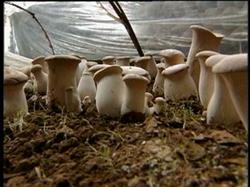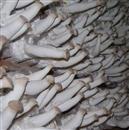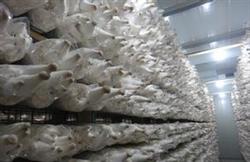Six tips for high yield cultivation of Pleurotus eryngii indoors and outdoors

The body of Pleurotus eryngii is fat and long, with a stout and smooth stalk, 2.5 cm in diameter and 10 cm in length; the lid is 4 cm in diameter, slightly concave in the middle, and the yellow fold is smooth. It is called snow antler because of its snow-white color. Because it contains almond flavor, the Japanese call it Tricholoma, which is a newly developed rare mushroom species in recent years. The meat of Pleurotus eryngii is crisp and tender, regular eating can prevent cardiovascular disease, diabetes and obesity, and has health functions such as bowel surgery. Therefore, put on the market, favored by consumers at home and abroad, become a fashion Shanzhen. Six tips for high yield cultivation of Pleurotus eryngii indoors and outdoors are introduced below. First, Pleurotus eryngii belongs to the fungus with low medium temperature in the best cultivation season. The optimum temperature for mycelium growth and mushroom production was 23-25 ℃ and 12-18 ℃ respectively. According to the requirements of the characteristics of bacterial temperature, the southern part of the cultivation season should be inoculated in late October, cultured for 45-50 days, and enter into mushroom in the first ten days of December. Inoculated in the first ten days of October in the north, the vegetables were cultivated in the greenhouse and the mushrooms were produced as usual in winter. Second, the scientific preparation of culture medium Pleurotus eryngii has strong adaptability, such as mixed sawdust, cottonseed hull, corncob, bagasse and so on. The commonly used formulations are: ① sawdust 77%, wheat bran or rice bran 16%, corn flour 5%, sugar 1%, gypsum powder 1%; ② cottonseed hull 46%, miscellaneous sawdust 35%, wheat bran 15%, corn meal 2%, calcium carbonate 1%, sugar 1%; ③ corncob 50%, cottonseed husk 30%, wheat bran 15%, corn flour 3%, sugar 1%, calcium carbonate 1%. The ratio of material to water in the above formula is 1 ∶ 1: 1.2. Pleurotus eryngii is suitable for bag cultivation, and the cultivation bag is suitable for polypropylene 15cm × 30cm × 0.04cm bag. The culture material is mixed and stirred evenly, the water content is 60%, and the ph value before sterilization is 6.5-7. The loading is tight and loose, and the material surface is flattened. Make a hole in the center and go deep into the material. The loading volume accounts for 60% of the bag length, and the wet weight of each bag is 400 to 450 grams. The mouth of the bag can be stuffed with cotton sleeve, or it can be fastened directly and then fastened by reverse folding. Material bag sterilization: high pressure 1.5 kg / cm 2 pressure, keep 2 hours 2.5 hours; atmospheric pressure sterilization 18 hours 20 hours, after reaching the standard, unload the bag while hot to cool. Third, when the suitable temperature inoculation and temperature control bacteria waiting bag is cooled below 23 ℃, put it in the inoculation box or aseptic room to connect Pleurotus eryngii strains. When inoculating, open the mouth of the bag and insert the seed into the hole of the material surface and extend it down slightly. Handbag mouth stopper cotton or tie mouth, every 750 grams of bottled bacteria can receive 50-60 bags. After inoculation, bacteria were cultured in a pre-sterilized dry room. The temperature is controlled at 23-25 ℃, the highest is no more than 28 ℃, and the lowest is 18 ℃. The mycelium was colonized at 5-7 days after inoculation, and the metabolism was accelerated and the bacterial temperature increased 20 days later, and the room temperature should be adjusted to 22-23 ℃. During the germicidal period, the relative humidity of the indoor space is controlled below 70%, and the air is ventilated once or twice a day to keep the air fresh. Fourth, arrange bags to promote buds according to local conditions, after 40-45 days of culture, the mycelium is thick and white in the bag, and the mycelium is physiologically mature, so the wormwood bag will be moved into the indoor mushroom house or the field shade shed in time. The site should be disinfected in advance, and the indoor mushroom room should be discharged with a layer of 5 to 6 layers, with a distance of 25 cm; the field shade shed and the ground should be integrated into a concave border bed in order to make use of the ground temperature and humidity. The bamboo and wood strips beside the border are bent and covered with a film, and the bacterial bags are placed close to the vertical discharge. After arranging the bag, untie the mouth of the bag, straighten the bag film, and let the mycelium grow in the space in the bag. You can also scratch the bacteria on the mycelium around the bag after opening. Spray once toward the space and bag surface after opening, and the relative humidity requires 80%. Indoor cultivation should cover the bag with newspaper and spray water to moisturize. The temperature of budding stage was 15-18 ℃, which could stimulate primordium differentiation and promote the occurrence of mushroom buds. Fifth, the strict management of mushroom period from the formation of primordium to the maturity of fruiting body usually takes 13-15 days. The young mushroom grows in the microclimate in the bag, when the mushroom body is close to the mouth of the bag, open the newspaper, let the fruiting body extend into the space, spray water once or twice a day, the relative humidity is 85% 90%; the natural humidity in the field mushroom shed film is more suitable, there is no need to spray water, but it is sprayed once a day during drought. Whether it is sunny or rainy, remove the film and ventilate for 30 minutes every day. The temperature during the growing period of fruiting body was controlled above 12 ℃ and below 18 ℃. When the temperature is low in winter, it should be heated and cultivated, but attention should be paid to the elimination of carbon dioxide. If the ventilation is poor, deformed mushrooms will occur when the concentration of carbon dioxide exceeds 0.1%. In order to make the mushroom body white and moist, with the characteristics of snow, the top of the mushroom shed should be sunshaded to prevent the mushroom body from being blackened by strong light. The suitable illuminance is 150 to 200 lux. Sixth, timely harvest and processing of Pleurotus eryngii from inoculation to the first tide of mushroom harvest, generally 55-60 days. The yield is high, the fruiting body is solitary or clustered, the initial stage is round, the mushroom stalk is thick and long at maturity, the cover is flat, the middle is concave, and the surface is slightly tomentose. Hold the stalk in hand when harvesting, pull up the whole flower. Clean up the residue and environment of the material surface after harvest, stop spraying water, and keep the bacteria alive for 5-7 days, then continue to spray water, control temperature and ventilation to promote the regeneration of the second tide mushroom. Pleurotus eryngii was properly managed with a bioconversion rate of 100%. Each bag generally grew 1 at a time, and some grew 2-3. A single flower weighs 50g to 80g, with a maximum weight of 150g. Mushroom products can be kept fresh for export, or cut into flakes for dehydration and drying, which should be sold all the year round.
- Prev

Introduction to the characteristics of Pleurotus eryngii
Pleurotus eryngii, also known as Pleurotus ostreatus (Pleurotuseryngi), has almond flavor, and its fleshy meat is similar to that of abalone, so it is named Pleurotus eryngii. In Japan, it is called "snow antler". It is saprophytic and parasitic on the roots and surrounding soil of Erygiumcampestre, a plant of Umbelliferae from late spring to early summer. It comes from.
- Next

Bud thinning technique of Pleurotus eryngii
During the cultivation of Pleurotus eryngii, the mushroom farmers did not take the necessary bud thinning in time, which led to the growth of many small mushroom buds on both sides of the bag after primordium differentiation. However, due to the limitations of nutrition and space, most of these mushroom buds can not grow into commercial mushrooms, losing the commodity price.
Related
- Fuxing push coffee new agricultural production and marketing class: lack of small-scale processing plants
- Jujube rice field leisure farm deep ploughing Yilan for five years to create a space for organic food and play
- Nongyu Farm-A trial of organic papaya for brave women with advanced technology
- Four points for attention in the prevention and control of diseases and insect pests of edible fungi
- How to add nutrient solution to Edible Fungi
- Is there any good way to control edible fungus mites?
- Open Inoculation Technology of Edible Fungi
- Is there any clever way to use fertilizer for edible fungus in winter?
- What agents are used to kill the pathogens of edible fungi in the mushroom shed?
- Rapid drying of Edible Fungi

